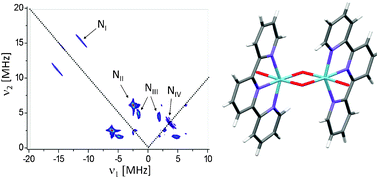We use two-dimensional hyperfine sublevel correlation (HYSCORE) spectroscopy to investigate the coordination geometry of the nitrogen ligands of biomimetic models of the oxygen-evolving complex of photosystem II. In the 2D HYSCORE spectroscopy study, [(bpy)2MnIII(μ-O)2MnIV(bpy)2](ClO4)3 (bpy, 2,2′-bipyridine) (1) and [H2O(terpy)MnIII(μ-O)2MnIV(terpy)OH2](NO3)3 (terpy = 2,2′:6′,2″-terpyridine) (2) exhibit electron-nuclear hyperfine interactions that depend on both the oxidation state of the manganese ion and the geometry of the nitrogen ligand. We observe four types of 14N hyperfine interactions corresponding to the Mn(III) and Mn(IV) ion of each mixed-valence complex and the equatorial and axial geometry of the ligand, respectively. The strongest and the weakest hyperfine interactions arise from the axial and equatorial ligands of the Mn(III) ion, respectively. The hyperfine interactions of intermediate strength are due to the axial and equatorial ligands of the Mn(IV) ion. Based on the results of this study, we assign the location and ligand geometry of the Mn(III) ion of the tetranuclear manganese–calcium–oxo cluster in the S2 state of photosystem II.

